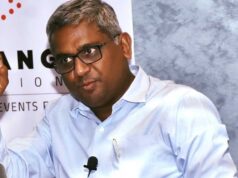Authored by Jeanine Joy, Ph.D.
The Road to Mindfulness and Beyond
My parents taught me to work hard for what I wanted. I took the advice to heart.
I averaged a promotion a year during the first six years I worked in the financial services industry but when it came time to make the leap from manager to leader, I realized that I didn’t have a way to measure when I’d accomplished enough.
It felt like I was on a hamster wheel because there was no barometer or ruler that told me, “Yes, Jeanine, now you’re ready for a leadership role.” I was blessed with intelligent parents but they simply didn’t have the experience to guide me any further.
When I read her article, it struck me that the concept of work/life balance has the same issue I had in deciding when I was ready for leadership roles—there is no barometer that objectively defines work/life balance.
While I was doing the research and writing our burnout prevention book (co-authored with Phil Geissinger), I read an article a surgeon wrote describing her search for work/life balance when she was on maternity leave. I’d never been drawn toward the concept of work/life balance.
When I read her article, it struck me that the concept of work/life balance has the same issue I had in deciding when I was ready for leadership roles—there is no barometer that objectively defines work/life balance. That’s why it never appealed to me. There isn’t a way to measure success. It’s not a SMART goal.
The surgeon’s journey echoed in many of the other published writings I read about work/life balance, expressed frustration at attempting to achieve an undefined goal. People who wrote, repeatedly said that they found attempting to achieve work/life balance increased the stress they experienced because they were searching for something they couldn’t define.
_____
READ ALSO: Stillness of the Mind in Life and Leadership: Interview with Buddhist Teacher Marie Kronquist
_____
It wasn’t until the surgeon’s third maternity leave that she found that simply going with her gut—doing what felt best to her at any given time—led to the least amount of stress and greatest sense of fulfillment.
It was nice to read that since I teach people how to use the revised definition of the purpose of emotions as output from a sensory feedback system designed to guide our behavior. This is essentially the same as trusting our gut if the person understands how to accurately interpret the meaning of the emotions they are feeling.
Going with you Gut Feeling: Trust your Emotions
“Trust your gut” doesn’t take us far enough because society has taught most of us to misinterpret what our emotions mean, which leaves people confused and not able to achieve optimal results.
Our emotions tell us whether the thought we’re thinking is stressful or not. The more stressful the thought is, the worse it feels. The further off the path toward our goals we have drifted, the worse it feels.
Mindfulness
This brings us to mindfulness which is accepting how we feel. Mindfulness allows us to relax more and not react in unhealthy ways but it does not take us far enough toward the possibilities. Mindfulness practiced with acceptance will improve our lives and our decisions but it will not optimize either.
Mindfulness with advanced stress management strategies, instead of mere acceptance, changes our thoughts in a productive and positive direction that leads to better results in every area of life.
_____
READ ALSO: Otto Scharmer – The World of Today and Tomorrow
_____
Today, a lot of people will tell you that the human mind evolved to focus on the negative. They’re wrong.
The human mind focuses on what it is trained to focus on. The mind can be re-programmed. Focusing on the positive is not blind optimism. In a review of the literature on the effects of optimism, the following point was made about optimists and action:
“It might seem paradoxical that people who expect good things to happen to take active steps to make sure good things do happen. But experience presumably teaches people that their own efforts play an important part in many kinds of life outcomes. Optimists may be more confident than pessimists that their efforts will be successful. For that reason, they are quicker to engage in those efforts when there is a need for them.”
A focus on the negative sees what it does not like and complains, “We can’t do this. This is wrong. I don’t like this.” There is nothing productive or life-affirming in a negative bias. The same literature review that found optimists are more likely to take actions that will improve success found that pessimists are more likely to give up on efforts to improve themselves and their habits.
Mindfulness with acceptance sees that we do not like something and assures us “We are okay even if that problem exists.” It soothes. But it does not steer our thoughts toward being active agents of change.
The best it can do, which isn’t a small measure, is to allow us greater access to our intuitive abilities which are enhanced as stress declines. That is the fruit most people pluck with a regular habit of mindfulness. It is enough to nourish them and keep them going.
The Smart Way™ – the Mindful Way
The Smart Way™ is mindful of how we feel while recognizing it is our thoughts, perceptions, and beliefs that generated the emotion and actively seeks to identify thoughts and beliefs that will lead to emotions that are more positive. This means we are more likely to act on those ideas.
An individual who uses The Smart Way™ accepts the emotions they feel as nothing more than feedback that tells them whether the perspective they are talking about the current situation is serving their highest good or not.
They also recognize that negative emotion is an indicator that the mind and body are experiencing stress. They know less stress is healthier.
The Smart Way™ practitioner doesn’t complain about what is, or attempt to be okay with the way things are, or fight against what is. They recognize that as soon as they know what they do not like, there is an opposite answer ready to be harvested.
The fruit that is ripe is the answer to, “What do we want? What can we do to make it happen? What is the first step?” Once they identify the first step, they know that focusing on what they can do will feel good and taking the steps they’ve identified that move them closer to what they want will feel good.
They can live in a world that is not as they want it to be and feel good because they are making positive contributions toward creating the world they prefer. They don’t just survive another day, they flourish and thrive.
Unlike work/life balance, emotional feedback has a barometer. The measurement is built-in, an active feature of a healthy body as much as our eyesight is built-in to the way our bodies are designed.
Our eyes are a sensory feedback system just like our emotions. Life forms that do not have eyes have a rudimentary emotional feedback system that guides them toward positive environments and away from danger. One-celled amoebas know how to use their sensory feedback system to guide them, it’s time humans began using theirs.
The benefits of learning toward the positive pay enormous dividends in terms of physical and mental health and improved relationships.
A White Paper that details much of the science that supports this statement will be published. You’ll be able to download a free copy. The executive summary is there now.









It can be easy to rush through life without stopping to notice much. Paying more attention to the present moment – to your own thoughts and feelings, and to the world around you – can improve your mental wellbeing. Thanks for sharing!
Thank you, Dennis.
Yes, it is easy not to notice.
Most of us think about 60,000 a day and most of our thoughts are habitual. In other words, they aren’t thoughtful thoughts. That’s a good thing because thinking about every thought we think would be trying at best. But not recognizing thoughts that aren’t’ serving us can lead to poor outcomes. Our emotions highlight those thoughts for us so instead of thinking about 60,000 thoughts, we just have to turn in to our emotional response and consider reconsidering the wisdom of thinking the thought that causes discomfort. It’s a really great system when it is used correctly.